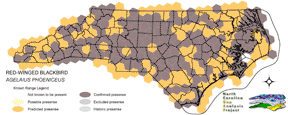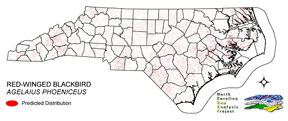
| Taxa: |
| Order: |
| Family: |
| Aves |
| Passeriformes |
| Icteridae |
| NatureServe Global Rank: |
| NatureServe State (NC) Rank: |
| G5 |
| S5B,S5N |
| Federal Status: |
| NC State Status: |
| --- |
| --- |


| Land Unit |
| US Fish & Wildlife Service |
| US Forest Service |
| US National Park Service |
| US Department of Defense |
| NC State Parks |
| NC University System |
| NC Wildlife Res. Com. |
| NC Forest Service |
| NC Div. of Coastal Mgmt. |
| Local Governments |
| Non-Governmental Org. |
| Other Public Lands |
| Private Lands |
| GAP Status 1-2 |
| All Protected Lands |
| Statewide |
| Hectares |
| 7,860.42 |
| 4,486.05 |
| 8,004.15 |
| 2,524.77 |
| 1,171.17 |
| 245.34 |
| 3,185.28 |
| 116.49 |
| 930.69 |
| 210.96 |
| 810.18 |
| 563.58 |
| 564,413.40 |
| 14,782.53 |
| 28,526.88 |
| 594,522.48 |
| Acres |
| 19,423.52 |
| 11,085.27 |
| 19,778.68 |
| 6,238.84 |
| 2,894.02 |
| 606.25 |
| 7,871.00 |
| 325.36 |
| 2,299.78 |
| 521.29 |
| 2,002.00 |
| 1,392.64 |
| 1,394,695.61 |
| 36,565.93 |
| 70,528.95 |
| 1,469,134.27 |
| % of Dist. on |
| Prot. Lands |
| 27.6 % |
| 15.7 % |
| 23.7 % |
| 8.9 % |
| 4.1 % |
| 0.9 % |
| 10.5 % |
| 0.4 % |
| 3.3 % |
| 2.8 % |
| 2.8 % |
| 1.4 % |
| < 0.1 % |
| 51.8 % |
| ----- |
| ----- |
| % of Dist. on |
| All Lands |
| 1.3 % |
| 0.8 % |
| 1.3 % |
| 0.4 % |
| 0.2 % |
| < 0.1 % |
| 0.5 % |
| < 0.1 % |
| 0.2 % |
| < 0.1 % |
| 0.1 % |
| < 0.1 % |
| 94.9 % |
| 2.5 % |
| ----- |
| ----- |
|
Common throughout the state (Potter et al. 1980). Nests in freshwater or brackish marshes (Ehrlich et al. 1988), shrub swamps, grasslands (Nicholson 1997), lake margins, and other open habitats (Potter et al 1980). At the beginning of the breeding season, males forage primarily in upland meadows and farmlands; once the females arrive on the breeding grounds, males spend more of their time foraging there (Skutch 1996). In marshes, nests are built near or over water (Ehrlich et al. 1988) in clumps of cattail or in bulrushes, shrubs, or small trees. In upland habitats, nests are placed in sturdy herbaceous plants or occasionally on the ground (Nicholson 1997). Insects are gleaned from (Ehrlich et al. 1988) and males display on emergent vegetation (Skutch 1996). NATURE SERVE GLOBAL HABITAT COMMENTS: Fresh-water and brackish marshes, bushes and small trees along watercourses, and upland cultivated fields; in migration and winter also in open cultivated lands, plowed fields, pastures and prairie (AOU 1983). BREEDING: Usually nests near water, in cattails, rushes, sedges; occasionally in shrubs or trees. |
| Code | Name | Description | NC Natural Heritage Program Equivalent |
| 3 | Tidal Marsh | Fresh and brackish tidal marshes, including cord grass, wild rice, sawgrass and needlerush alliances. | Brackish Marsh, Interdune pond, Maritime wet grassland |
| 124 | Maritime Scrubs and Tidal Shrublands | Coastal shrubs including wax-myrtle, swamp rose, alder, yaupon, and greenbriar. | Maritime Shrubs, Salt Shrub |
| 372 | Interdune Herbaceous Wetlands | Dune swales with permanently flooded to intermittently exposed hydrology. Species composition depends on salinity and can include cut grass, spike-rush, mosquito fern, and hornwort. | Interdune Pond, Maritime Wet Grasslands |
| 371 | Maritime Grasslands | Dune grass community consisting of sea oats and beach grasses. | Dune grass, Maritime dry grassland |
| 380 | Coastal Plain Fresh Water Emergent | Emergent vegetation in fresh water seepage bogs, ponds and riverbeds of the coastal plain. Includes alliances dominated by sedges, eelgrass, as well as cane found in unforested cane-brakes. | Small Depression Pond, Sandhill Seep, Floodplain Pool, Unforested Floodplain Canebrake, Riverscour Prairies, Vernal Pools |
| 173 | Coastal Plain Riverbank Shrubs | Shrub dominated riverbanks, commonly dominated by willows and/or alders. | Sand and Mud Bar |
| 87 | Pocosin Woodlands and Shrublands | Includes pond pine woodland, low pocosin and high pocosin shrub dominated areas. Canebrakes and bay forests may be present. | Pond Pine Woodlands, Peatland Canebrake, Small Depression Pocosin |
| 67 | Wet Longleaf or Slash Pine Savanna | Wet flatwoods and pine savannas, typically dominated by longleaf pines, but slash or pond pines may be the dominant pines. | Wet Pine Flatwoods |
| 239 | Piedmont/Mountain Emergent Vegetation | Emergent vegetation of all wetland hydrologies. Sites would commonly support species such as tussock sedge, rushs, and cattail alliances. | Rocky Bar and Shore (in part) |
| 267 | Riverbank Shrublands | Riverside shrubs with temporarily flooded hydrologies. Found in the both the Mountains and Piedmont. Containing dominants such as smooth alder and a Carolina or black willows. | Sand and Mud Bar |
| 269 | Floodplain Wet Shrublands | Saturated shrublands of the Piedmont, includes buttonbush, swamp-loosestrife, decodon and alders. | Piedmont/mountain Semipermanent Impoundment |
| 180 | Agricultural Crop Fields | Farm fields used for row crops. | No equivalent |
| 205 | Agricultural Pasture/Hay and Natural Herbaceous | Farm fields used for pasture grass or hay production, as well as old fields dominated by native and exotic grasses. | No equivalent |
| 202 | Residential Urban | Includes vegetation interspersed in residential areas. Includes lawns, mixed species woodlots, and horticultural shrubs. Vegetation accounts for between 20 - 70% of the cover. | No equivalent |
|
Dolbeer, R. A., P. P. Woronecki, and J. R. Mason. 1988. Aviary and field evaluations of sweet corn resistance to damage by blackbirds. J. Am. Soc. Hortic. Sci. 113:460-464.
Nelms, C. O., et al. 1994. Population estimates of breeding blackbirds in North Dakota, 1967, 1981-1982, and 1990. Am. Midl. Nat. 132:256-263. Nicholson CP. 1997. Atlas of the breeding birds of Tennessee. Knoxville: University of Tennessee Press. Conover, M. R., and R. A. Dolbeer, 1989. Reflecting tapes fail to reduce blackbird damage to ripening cornfields. Wildl. Soc. Bull. 17:441-443. Cummings, J. L., J. L. Guarino, and C. E. Knittle. 1989. Chronology of blackbird damage to sunflowers. Wildl. Soc. Bull. 17:50-52. Straub, R. W. 1989. Red-winged blackbird damage to sweet corn in relation to infestations of European corn borer (Lepidoptera:Pyralidae). J. Econ. Entomol. 82:1406-1410. Bureau of Land Management. Life History Summaries. Dolbeer, R. A. 1990. Ornithology and integrated pest management:red-winged blackbirds AGELAIUS PHOENICEUS and corn. Ibis 132:309-322. Orians, G.H., Christman. 1968. Behavior of redwinged, tri-colored, and yellow headed blackbirds. Berkeley. 301 pp. Harrison, C. 1978. A field guide to the nests, eggs and nestlings of North American birds. Collins, Cleveland, Ohio. Dolbeer, R. A. 1980. Blackbirds and corn in Ohio. U.S. Fish and Wildl. Serv., Resource Publ. 136. 18 pp. Orians, G. H. 1980. Some adaptations of marsh-nesting blackbirds. Princeton Univ. Press. 295 pp. Potter, E. F., J. F. Parnell, and R. P. Teulings. 1980. Birds of the Carolinas. Univ. North Carolina Press, Chapel Hill. 408 pp. Terres, J.K. 1980. The Audubon Society encyclopedia of North American birds. Alfred A. Knopf, New York. American Ornithologists' Union. 1983. Checklist of North American birds. 6th ed. Allen Press:Lawrence, KS. 877 p. American Ornithologists' Union (AOU), Committee on Classification and Nomenclature. 1983. Check-list of North American Birds. Sixth Edition. American Ornithologists' Union, Allen Press, Inc., Lawrence, Kansas. Clark, R. G., et al. 1986. Numerical responses of red-winged blackbird populations to changes in regional land-use patterns. Can. J. Zool. 64:1944-1950. Nero, R. W. 1984. Redwings. Smithsonian Institution Press, Blue Ridge Summit, PA. 160 pp. Orians, G. H. 1985. Blackbirds of the Americas. Univ. Washington Press, Seattle. Clark, R. G., and P. J. Weatherhead. 1987. Influence of population size on habitat use by territorial male red-winged blackbirds in agricultural landscapes. Auk 104:311-315. Ehrlich, P.R., D.S. Dobkin, and D. Wheye. 1988. The birder's handbook:a field guide to the natural history of North American birds. Simon and Shuster, Inc., New York. xxx + 785 pp. Dolbeer, R. A., et al. 1991. Efficacy of two gas cartridge formulations in killing woodchucks in burrows. Wildl. Soc. Bull. 19:200-204. Stiles, F.G., and A.F. Skutch. 1989. A guide to the birds of Costa Rica. Comstock Publ. Associates, Cornell University Press, Ithaca, New York. 511 pp. Ball, R. M., et al. 1988. Phylogeographic population structure of red-winged blackbirds assessed by mitochondrial DNA. Proc. Nat. Acad. Sci. 85:1558-1562. Gavin, T. A., R. A. Howard, and B. May. 1991. Allozyme variation among breeding populations of red-winged blackbirds:the California conundrum. Auk 108:602-611. Glahn, J.F., et al. 1991. Impact of roost control on local urban and agricultural blackbird problems. Wildlife Society Bulletin 19:511-522. Mah, J., and G. L. Nuechterlein. 1991. Feeding behavior of red-winged blackbirds on bird-resistant sunflowers. Wildl. Soc. Bull. 19:39-46. |
For more information please contact them at:
NC-GAP Analysis Project
Dept. of Zoology, NCSU
Campus Box 7617
Raleigh, NC 27695-7617
(919) 513-2853
www.basic.ncsu.edu/ncgap